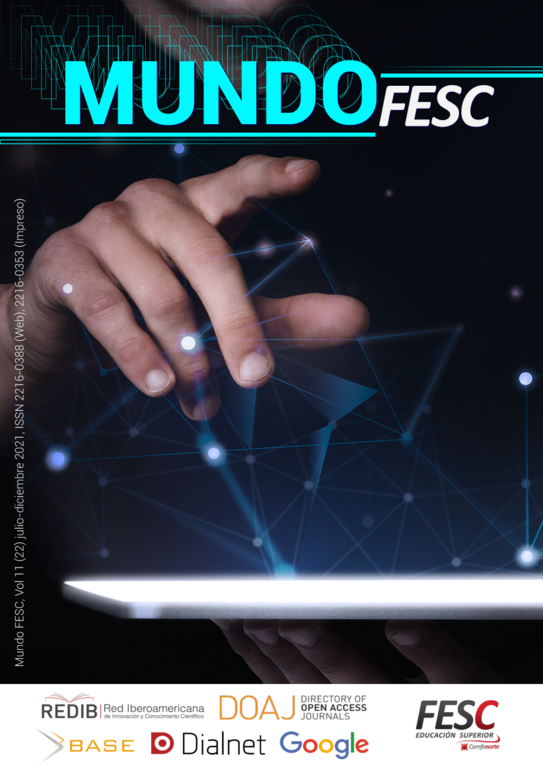Trends in computer intelligence
Keywords:
Computational intelligence; Computational methods; Bibliometric networks; Intelligent SystemsAbstract
This article presents those results derived from a systematic review of the literature focused on the recognition of computational intelligence worldwide. The methodological development was constituted in four different facets: - the elaboration of search equations, - the verification of the quality and relevance of the documents, - the elaboration of schemes for the recognition of the trends, - the investigation of confluences and differences. 55 articles from the Scopus® and Web of Science® databases were examined in VOSviewer® software for the construction and visualization of bibliometric networks and term concurrence; resulting in machine learning, classification, artificial intelligence, feature selection, algorithm classification, neural networks, intelligent systems among others. This study yields results from various fields of evolutionary learning for data collection to provide new and diverse faster applications, allowing data optimization and new prediction strategies or tools.
Downloads
References
K. Börner, C. Chen, y K. W. Boyack, “Visualizing knowledge domains”, Annu. Rev. Inf. Sci. Technol., vol. 37, pp. 179–255, 2003
C. Okoli y K. Schabram, “Guide to Conducting a Systematic Literature Review of Information Systems Research”, Work. Pap. Inf. Syst., 2010
M. Dixon-Woods, S. Agarwal, D. Jones, B. Young, y A. Sutton, “Synthesising qualitative and quantitative evidence: a review of possible methods”, J. Heal. Serv. Res. Policy, vol. 10, núm. 1, pp. 45–53, ene. 2005
A. J. Onwuegbuzie, N. L. Leech, y K. M. T. Collins, “Qualitative Analysis Techniques for the Review of the Literature”, 2012
M. J. Grant y A. Booth, “A typology of reviews: an analysis of 14 review types and associated methodologies”, Heal. Inf. Libr. J., vol. 26, núm. 2, pp. 91–108, jun. 2009
A. Christoforou y A. S. Andreou, “A Multilayer Fuzzy Cognitive Maps approach to the cloud adoption decision support problem”, en IEEE International Conference on Fuzzy Systems, 2015, vol. 2015-November, pp. 1–8
S. S. Ge, T. M. Guerra, F. L. Lewis, J. C. Principe, y M. Colnarič, “Computational Intelligence in Control”, IFAC Proc. Vol., vol. 47, núm. 3, pp. 8867–8878, 2014
S. Saeedi, R. Chavarriaga, R. Leeb, y J. D. R. Millan, “Adaptive Assistance for Brain-Computer Interfaces by Online Prediction of Command Reliability”, IEEE Comput. Intell. Mag., vol. 11, núm. 1, pp. 32–39, feb. 2016
L. Wang, Q. Zhang, A. Zhou, M. Gong, y L. Jiao, “Constrained Subproblems in a Decomposition-Based Multiobjective Evolutionary Algorithm”, IEEE Trans. Evol. Comput., vol. 20, núm. 3, pp. 475–480, jun. 2016
V. Piuri, F. Scotti, y M. Roveri, “Computational intelligence in industrial quality control”, en IEEE International Workshop on Intelligent Signal Processing - Proceedings, 2005, pp. 4–9
E. Lakshika y M. Barlow, “Computational Intelligence Approaches to Computational Aesthetics”, 2018, pp. 81–92
M. Frank, D. Drikakis, y V. Charissis, “Machine-learning methods for computational science and engineering”, Computation, vol. 8, núm. 1. MDPI Multidisciplinary Digital Publishing Institute, 01-mar-2020
D.Fogel, “Evolutionary computation - toward a new philosophy of machine intelligence”, 1995
J.C. Bezdek, “Computational Intelligence Defined - By Everyone !”, en Computational Intelligence: Soft Computing and Fuzzy-Neuro Integration with Applications, Springer Berlin Heidelberg, 1998, pp. 10–37
D. Poole, A. Mackworth, y R. Goebel, Computational Intelligence: A Logical Approach. New York: Oxford University Press, 1998
A. Kusiak, “Computational Intelligence in Design and Manufacturing”, Assem. Autom., vol. 21, núm. 3, pp. 275–276, sep. 2001
S. Dick y A. Kandel, Computational Intelligence in Software Quality Assurance, vol. 63. WORLD SCIENTIFIC, 2005
Y. Q. Chen y Z. Yi, “Computational intelligence in control engineering”, Int. J. Robust Nonlinear Control, vol. 14, núm. 12, pp. 1081–1083, ago. 2004
A.P. Engelbrecht, Computational Intelligence: An Introduction: Second Edition. John Wiley and Sons, 2007
D. P. Hudedagaddi y B. K. Tripathy, “Quantum inspired computational intelligent techniques in image segmentation”, en Quantum Inspired Computational Intelligence: Research and Applications, Elsevier Inc., 2017, pp. 233–258
T. Hanne y R. Dornberger, “Adapting the Teaching of Computational Intelligence Techniques to Improve Learning Outcomes”, en Studies in Systems, Decision and Control, vol. 294, Springer, 2021, pp. 113–129
N. Ansari y N. Hou, Computational Intelligence for Optimization , 1a ed. New York: Springe US, 1997
A. E. Hassanien, A. Abraham, y F. Herrera, Foundations of Computational Intelligence , vol. 2. 2009
A. Kroll y R. Mikut, “Computational Intelligence”, At-Automatisierungstechnik, vol. 56, núm. 7, pp. 335–338, ene. 2008
R. C. Eberhart y Y. Shi, Computational Intelligence. Elsevier Inc., 2007




